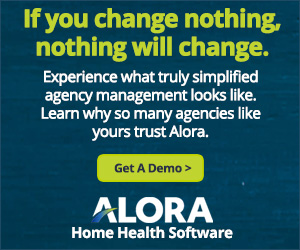
31 Oct Start and Resumption of Care in Home Health
Avoiding common problems and how to speed up the process
Successful flow in home health agency care operations from an initial client referral, or a notification of discharge to the home health visit relies heavily on coordinated efforts between multiple stakeholders. This process often needs to be ironed out frequently to remove the wrinkles of miscommunication, and delays in processing, scheduling, and reimbursement. The slim time frame agencies are given by the Centers for Medicare and Medicaid (CMS) for initial assessment visits and updates of the comprehensive assessment add a layer of pressure on home health agencies. Unfortunately, agencies often race to meet admission and resumption requirements but get slowed down by bottlenecks in the transfer of information. Is your agency keeping the pace required to be successful?
Interoperability
Sharing is caring. This commonplace phrase applies not only to young children but also to the broader nationwide healthcare environment. The well-known silos between different healthcare organizations can, and often do, lead to delays in care and poor outcomes. Though advances have been made in the standards of information sharing with legislation such as the IMPACT Act of 2014, and home care software capabilities, there is still work to be done. The Assistant Secretary for Technology Policy/Office of The National Coordinator for Health Information Technology (ASTP) supports ongoing initiatives and standards for healthcare system information technologies. Interoperability is summarized as the ability of each care team member within a patient’s health journey to easily have access to all essential electronic health information for the purpose of coordinating care and improving workflows. Interoperability is identified as a pain point for many healthcare organizations due to the variety of platforms utilized that often do not easily integrate. Advancing information sharing systems in your home health agency both internally and with outside parties can greatly reduce common problems with the start or resumption of care such as:
- The omission of essential details for proper intake, and time wasted searching for information across multiple systems prior to a comprehensive visit.
- Delayed transfer of discharge paperwork or delayed notification of discharge after a 24-hour admission.
- Coordination of care issues such as the inability to have adequate staff or communicate with patients to confirm visits.
- Redundant paperwork and administrative tasks, and human error associated with data entry.
Workflow Solutions
Due to the complex nature of the industry, agency leaders must evaluate and choose wisely which home health agency technologies they employ within their organization. It is also vital for leaders to perform ongoing scrutiny of the ability of the adopted electronic health technologies to ensure it is working for them. The ASTP has studied the problems in healthcare organization technology nationwide. They strongly encourage organizations to ensure their healthcare delivery is improving patient care by using electronic data meeting the three “rights”; The right data at the right time and the data is available to the right people. Further, ASTP urges agencies to evaluate their home health electronic health record systems for several critical areas such as:
- The ability to seamlessly interact with the user (remote monitoring, e-prescribing).
- Communicate within the organization, patients, and external stakeholders (electronic referrals, secure patient and care team messaging).
- The ability to process and manage information across organizations (easily accept patient data electronically that is pertinent and essential for the visit).
- User-friendly integration amongst multiple types of devices and applications (tablets, smartwatches, smartphones).
Expert Recommendations
The National Association for Home Care and Hospice Expo in 2023 featured many key presenters on topics related to improving the use of technology in home health care. Expo presenters and home health experts Wesley, Albert, and Knowlton (2023) provided an information session with an outcome aimed at exploring recommendations to improve interoperability strategies that promote growth and success for homecare agencies. Although there may be an upfront cost associated with the suggestions, the return on investment is often invaluable, leading to improved growth and success of the organization. Key summaries included suggestions such as:
- Addressing the problem of homecare staffing turnover by using technology tools to create a more user-friendly point-of-care charting system.
- Seamlessly connecting direct care providers to others for collaboration and communication to feel supported and reduce the burden on administration.
- Utilizing a system that allows for easy streamlined care coordination while reducing manual operations associated with human error.
- Improving the ease of workflow with the referring provider from accepting electronic data to also allowing the exchange of progress notes back to the referring provider.
- Utilizing a system that holistically supports the user with training and implementation as well as customer support.
Leaders of home health agencies can also narrow in on their specific areas of improvement within their healthcare technology by asking the front-line users what information they might be missing to do their job well. The Journal of American Medical Informatics Association publishes research that often reviews concerns about data sharing barriers. Amongst their published research is an article that identified how input from nurses should be utilized to inform the transfer standards for home health agency visits. This includes information such as a patient’s ability to self-administer medications to determine how soon the patient should be seen, as well as how more comprehensive assessment data should be included upon referral. This can set agencies up for success by sending the right staff members (specializing in wound care, experience with specialty types of active problems, drains, or other devices) to the visit.
Solutions to meet reimbursement requirements, improve care coordination, and help your agency stand out as a leader in seamless transitions of care for providers and patients primarily boils down to having solid technology tools including but not limited to home health software. Having a system that improves interoperability for the home health agency is a win for everyone involved when one system can smoothly manage each step in the process efficiently and provide ongoing support and training for the user. In order to unlock the true potential of an agency to move quicker in completing initial and resumption visits, home health agencies should invest in and prioritize implementation of interoperable technologies as the new standard for success.
Helpful links:
- Updates of the comprehensive assessment
- Initial assessment visit information
- IMPACT Act of 2014
- Input from nurses should be utilized to inform the transfer standards for home health agency visits
Author’s Note: Views, information, and guidance in this resource are intended for information only. We are not rendering legal, financial, accounting, medical, or other professional advice. Alora disclaims any liability to any third party and cannot make any guarantee related to the content.
Additional related blogs:

Alora’s home health software solution is ideal for agencies operating in both skilled and non-skilled care. Managing workflow for administrative and caregiving staff becomes easier with the right technology tools. Alora has been engineered with the goal of simplification of day-to-day tasks in the office and in the field, allowing agencies to focus on patient care, workflow efficiency, and growth.



No Comments